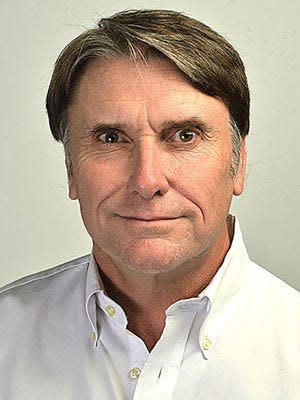Successful fusion reaction could be a powerful Christmas gift to the world
- Oops!Something went wrong.Please try again later.
In 1799, the Italian chemist Alessandro Volta produced an electric current by interspacing a stack of zinc and copper discs with cardboard soaked in salt water. This, elegantly known as a “voltaic pile,” was an improvement over past electrical currents, which had relied on materials that included the legs of a dead frog.
The radical breakthrough proved that electrical impulses were not dependent on living organisms, a claim some held as tightly as the assertion that the world was flat. When Volta published his findings, it caused a great stir in the scientific community, but of course was scarcely noticed by the general public.
The people, perhaps, knew better than to hold their breath. It wasn’t for another four decades that the principles of the voltaic pile — a battery — were put to practical use when Moritz von Jacobi ferried 14 people across the Neva River in an electric boat. The modern industrial age had begun.

Twelve days ago, scientists announced what one day may be considered the greatest Christmas gift to humanity since, if your theology leans this way, the Savior himself.
Working at a massive government testing site in California, they reported that they had aimed nearly 200 lasers at a fuel pellet the size of a mustard seed, touching off a fusion reaction that produced more energy than it took to shoot the lasers.
In classic, mad-scientist imagery, the experiment outperformed expectations, producing so much heat it fried the diagnostic equipment, leaving dazed physicists initially unsure what they had wrought.
More:Scientists achieve nuclear fusion breakthrough in historic experiment. How it works.
One day, this exotic, space-age experiment will seem as crude as Volta’s stacks of paper and metal. But in all likelihood, it will also be regarded as the singular turning point in the drive to replace the basic energy source, combustion, that has served the planet for the last 400,000 years. Like Volta’s pile, we will see no immediate benefits. There are many mountains yet to climb, but we may have reached the continental divide.
“If this is confirmed, we are witnessing a moment of history,” plasma physicist Arthur Turrell told the Financial Times. “Scientists have struggled to show that fusion can release more energy than is put in since the 1950s, and the researchers at Lawrence Livermore seem to have finally and absolutely smashed this decades-old goal.”
This could lead to a cheap and, for all practical purposes, inexhaustible supply of energy that leaves behind no planet-killing carbon and no lasting radioactive wastes. It would lift millions of people worldwide out of poverty. It would eliminate the impetus for most modern warfare, and many modern political arguments.
Because we see the bill, we understand the costs of fuel when it comes to filling up the car and heating our homes. But when we buy a carrot, what we are primarily paying for is energy: fuel to deliver seed, fertilizer and pesticide to the farm, diesel to plant, tend and harvest the crop and motor fuel to transport to get it to market.
Every business and household budget includes energy as a driving factor.
On the cusp:The two sides of downtown Hagerstown. Which one will prevail?
How might fusion change this? Consider that there will come a time that a teacup of hydrogen will theoretically be sufficient to meet all the energy needs of the average home — for hundreds of years.
We have long known the power and potential of fusion, which we see in action every day as the sun crosses the sky. We have tapped into that energy indirectly with our solar panels, which collect a very tiny fraction of the sun’s output; every minute of every day, the sun is bombarding the planet with 35,000 times the amount of energy used by the human race. But massive tracts of glass panels and hulking windmills have never seemed like a permanent answer.
For the planet to heal itself, the environmental writer Bill McKibbon has plainly noted that “we have to stop burning things,” but that has really never seemed possible until now. Still, pessimists look at the amount of time and work involved before fusion becomes the solution to our climate and energy woes, and write dismissive articles, as if 2060 will never get here. Blame a society in which we have come to appreciate instant gratification or nothing.
Better that we understand and celebrate this great moment in time, and use it to reflect on how, despite all our spats, the driving forces that have shaped our nation since its inception are still alive and well.
This is a great day for America, the greatest country on earth. As Putin is mired in the Ukrainian mud and Xi is overrun by disease, the American people and American government are elevating humanity, leading the world into a better and brighter place.
Merry Christmas indeed.
Tim Rowland is a Herald-Mail columnist.
This article originally appeared on The Herald-Mail: Fusion power could eliminate the cause of a lot of human strife
